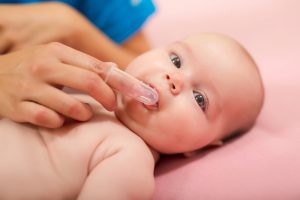How To Properly Brush Your Baby’s Teeth
Pacifiers and Teeth
February 8, 2019Can Bubble Gum Be Good For Children’s Teeth?
February 22, 2019
Infants begin developing their first teeth between 6 and 12 months of age. As soon as a tooth appears, parents should begin the brushing process to prevent tooth decay. But how should you brush your baby’s teeth, and should you use toothpaste? A baby’s oral health care is very important, and parents should be prepared by knowing how to care for their baby’s sensitive teeth. Find out when you should start brushing your baby’s teeth, how often, and what else you should do to help your baby have great oral health!
Why Baby Teeth Are Important
As adults, we do everything that we can to care for our permanent teeth and make sure that they’re healthy. For children, their baby teeth serve an important function in preparing the way for their future adult teeth. A baby’s 20 primary teeth are already present in the jaw at birth, and most infants have their first teeth erupt between six and twelve months of age, with the other teeth quickly erupting after the first. As baby teeth begin appearing, they help infants and toddlers chew, speak, and smile, and they hold the space in jaws for permanent teeth that are growing under their gums. If a baby tooth develops decay or falls out prematurely, it can cause permanent teeth to drift into the empty space, making teeth crooked or crowded in the future. Although they are not with us as long as our permanent teeth, protecting our baby teeth is important as they help maintain mouth health and can set a strong foundation for our permanent teeth before they begin developing.
Brushing Your Baby’s Teeth
It’s important to begin caring for your child’s teeth as soon as they appear. Infants begin to show signs of teething before the first baby tooth erupts, and this can be an uncomfortable time for little ones. Your baby’s gums might become red and swollen, and oftentimes drooling increases. To help your baby during this process, try some of the following tips:
- Rub their gums with your finger
- Have the baby suck on a cool teething ring or small spoon
- Apply a moisture gauze square to the gums
- Administer a child-appropriate pain reliever
As soon as your baby’s first tooth appears, begin brushing. Start at the gums and wipe them with a wet washcloth. An infant’s teeth does not need a toothbrush, and wiping the gums of an erupting tooth is enough to disturb any plaque that may be building there. You should “brush” your baby’s teeth twice daily, especially after eating and before bed. Once all baby teeth have erupted completely, you can begin using a toothbrush that is soft, small-headed, wide-handled, and preferably infant-specific size. For children younger than three, only use a smear of fluoride toothpaste on your child’s toothbrush, and afterwards only use a pea-size amount to avoid overexposure to the fluoride. Once they are old enough to brush on their own, make sure to supervise them so as to remind them to use the proper amount of toothpaste and avoid swallowing. Additionally, it is recommended that you use toothpaste that is approved by the American Dental Association to avoid toothpastes that have ingredients that are too abrasive for young children’s teeth. Similar to teeth brushing, whenever your child has two teeth that begin touching, begin flossing between them daily to remove any buildup of plaque or food particles.
Infant Dental Exams
After your child’s first tooth comes in or by their first birthday, schedule a well-baby checkup with your dentist to monitor their teeth. Besides checking for cavities and other issues, your dentist can show you how to properly brush your child’s baby teeth and handle unhealthy habits such as thumb-sucking, which can extremely alter your child’s jaw and teeth development. Many offices provide free infant dental exams for children under 18 months of age in which an exam is given in a “knee-to-knee” position. The dentist will sit knee-to-knee with the parent with the infant on the parent’s lap, allowing for the dentist to perform an examination of the child’s mouth while in the comfort of the parent’s lap. The child is positioned towards the parent with their legs wrapped around their waist, then the child is gently laid back into the dentist’s lap while the parent holds the child’s hands over the child’s stomach. Generally, the dentist will examine your child’s mouth with a soft toothbrush and a mirror. Although the examination is short and free of any invasive procedures, young children can often get fussy or cry during the exam. Rest assured, pediatric dentists are trained thoroughly on how to provide the best experience for your child in the quickest way possible. A baby’s first dental exam is vital in protecting against tooth decay in their newly formed teeth, and allows for the dentist to monitor their overall mouth health from an early age.
To schedule your baby’s first infant dental exam, call Hardy Pediatric Dentistry & Orthodontics at (720) 887-6003! Our pediatric dentists are highly trained and experienced at performing various dental procedures, and can help you start your infant’s dental experience on the right foot.